Menu
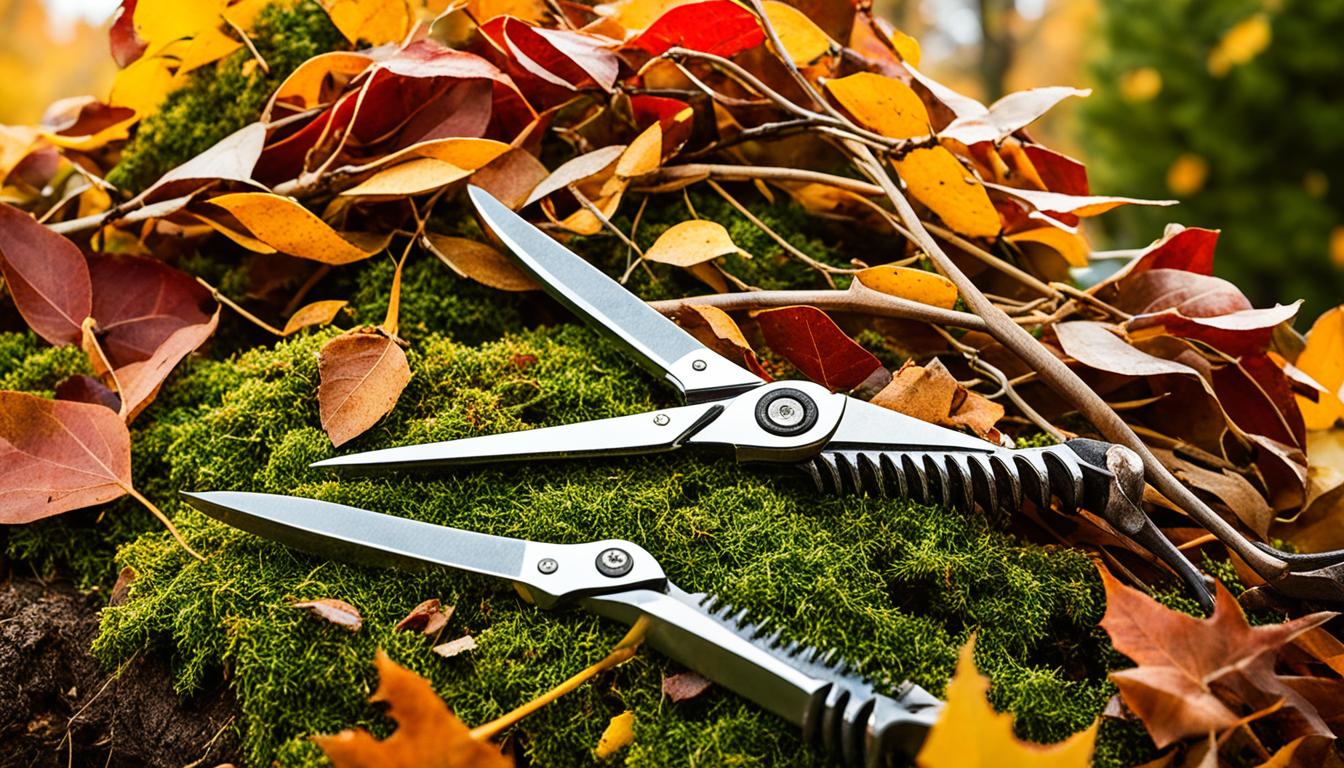
October is the perfect time to prune many deciduous trees and hardy shrubs. Autumn pruning is key for healthy growth and year-round beauty. It helps in the next growth cycle and avoids pests by cutting dead or sick branches. The right tools, like secateurs, are vital for this job.
Autumn pruning is key for keeping your garden in top shape. It involves trimming trees and plants. This helps them grow healthier and stronger next season.
Autumn pruning boosts new growth. Cutting unnecessary parts makes plants grow more evenly and bigger. This strengthens them for the coming seasons.
Getting rid of dead or sick branches in autumn stops diseases from spreading. This step is crucial. It keeps your garden healthy by avoiding widespread plant sickness. Also, it keeps your garden clean and disease-free.
Autumn pruning makes your garden look great. A garden that’s pruned well shows how much you care. It doesn’t just look good now but ensures plants grow nicely in the future. Regular pruning also keeps your landscape neat.
Overall, autumn pruning does a lot for your garden. It boosts growth, stops diseases, and makes it look better. By pruning trees and plants now, your garden will thrive, even in the cold.
Finding the right time to prune in autumn is key. It’s best done when plants are less active and almost dormant. October is a top pick for pruning many trees and shrubs. This is because the leaves have mostly fallen. It’s easier to see the tree’s shape and make accurate cuts.
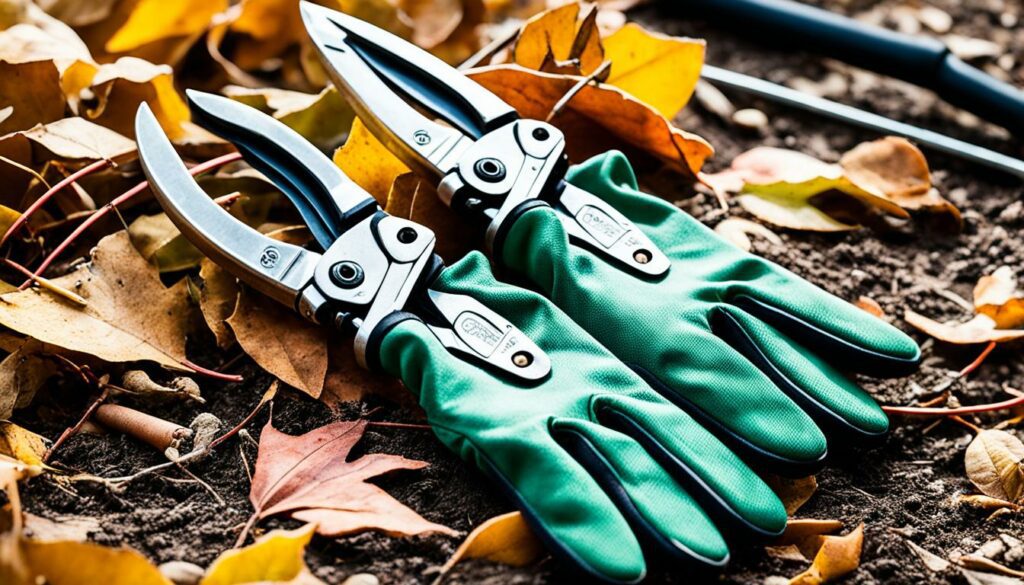
Perennials and flowers should be trimmed after the first frost. This choice stops pests and diseases from living in the dead parts. By trimming roses back to half their height, they’ll stay healthy and bloom well in spring.
Bushes that flower on last year’s wood should also be pruned in the autumn. This keeps them healthy and lets light and air through. Remember, not all plants should be pruned in autumn. For example, plums and similar types can get a disease if pruned then.
Properly getting rid of what you cut is also vital. Toss out anything that looks sick. This stops diseases from spreading. With these top pruning tips, your garden will look great and grow well next year.
Before you start pruning, it’s key to have the right garden tools for the job. Proper pruning can make trees and shrubs look better. It also stops harm that bad cuts might do. The right tools help us make precise, clean cuts. This keeps our plants healthy for longer.
Pruning shears are vital for any gardener. They’re for cutting small twigs and branches. It’s important that shears are sharp and clean. This makes a better cut and stops diseases spreading. Good shears save you time and make caring for plants easier.
Loppers are a must for cutting thick branches. They make it easier to cut through bigger branches. This means less work for you. Keep your loppers clean and sharp for the best results. They should be part of your gardening tools.
For the biggest branches, use a pruning saw. Pruning saws are for cutting very large branches. They have different sizes for various types of branches. A sharp and clean saw works best. It makes careful cuts that help your plants heal faster.
To sum up, choose your garden tools wisely for pruning. Use shears, loppers, and a saw correctly to keep your garden healthy. This way, your plants will be ready to grow in the next season.
Getting ready for autumn gardening is key. It ensures your plants stay healthy and you stay safe. Ensure you prep well.
Keeping your tools clean is very important in autumn. Clean shears and saw blades well. Use rubbing alcohol or a diluted bleach solution. This stops diseases from spreading in your garden.
Safety gear is a must when you prune. Wear thick gloves and safety glasses. Use a 3-legged ladder for safety on uneven ground. The right tools and safety gear are essential for good gardening.
Knowing the structure of plants helps a lot with autumn pruning. Understand the diameter of the trunk. This guides you on the right tools and methods.
Start with things like crotches, scaffolding, and watersprouts for fruit trees. This way, you can encourage healthy growth. Strategic knowledge makes your autumn gardening a success.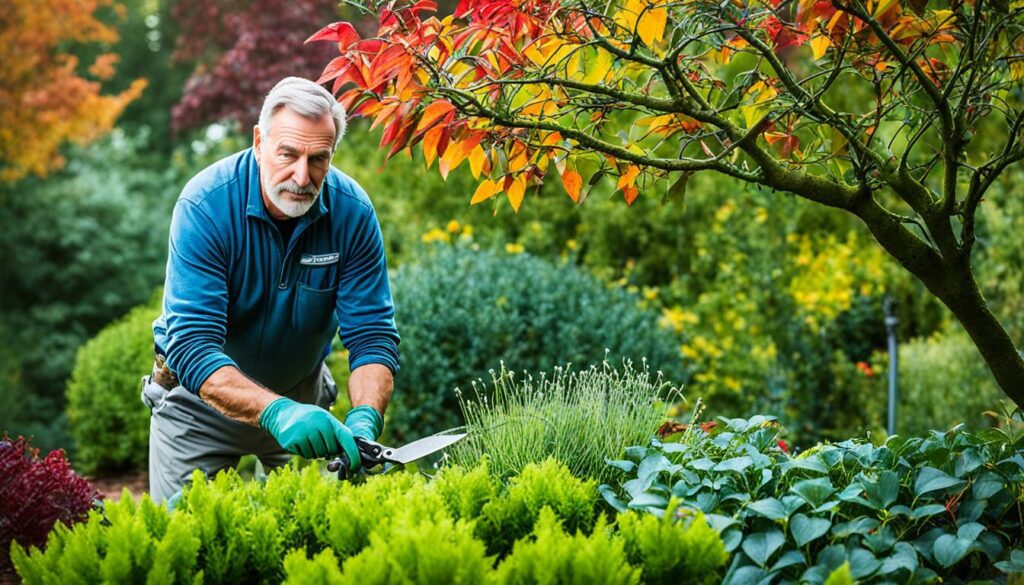
Now, let’s look at what tools to use when pruning plants of different types and sizes:
| Plant Type | Recommended Tools | Best Time to Prune |
|---|---|---|
| Fruit Trees | Hand pruners (Felco or ARS), long-handled loppers, hand-saw | November until bloom |
| Ornamental Trees | Hand pruners, long-handled loppers, pruning saw | Late winter |
| Berries | Hand pruners, small pruning saw | November until bloom |
| Flowering Shrubs | Hand pruners, long-handled loppers | During and immediately after bloom |
Follow these tips and use the right tools. This will make your autumn pruning work wonders. Your plants will thrive in the coming seasons.
Autumn is the best time for gardeners to use pruning to help plants grow strong. It’s a great moment to check on and fix trees, shrubs, and perennials. By tailoring the care to each plant type, they will stay healthy and flourish.
When it comes to trees, start by cutting away dead, damaged, or sick branches. This step improves air and light flow, key for good growth. Always aim for clean cuts near the branch collar to stop diseases. Doing this in October is great because many trees are dormant, making their shape clear.
“Pruning trees in late autumn safeguards their health and prepares them for vigorous spring growth.”
For shrubs, in autumn, focus on cutting back branches that are too big or crossing. This will make them look better and ready for the next year. A good tip is to cut shrubs like roses to about half their size. This boosts air movement and lowers thick growth, keeping shrubs well.
After the first frost, managing perennials is important to avoid diseases and pests. Cutting them right down to the ground in autumn works well. This step not only keeps them healthy but also helps them grow strong the next season. Using tools like bypass, anvil, or ratchet secateurs can make your work easier and more accurate, helping plants to grow back vigorously.
| Type of Plant | Pruning Technique | Timing |
|---|---|---|
| Trees | Remove dead, damaged, or diseased limbs | October to late autumn |
| Shrubs | Cut back overgrown or crossed branches | Autumn |
| Perennials | Prune down to the soil line | Post first frost |
Pruning deciduous trees in autumn is key as they go dormant. This is the best time to see their shape clearly for trimming. Without leaves, spots needing work are easy to spot. Cut off dead or sick branches to a healthy part to stop their problem spreading.
It’s also vital to remove water sprouts and suckers when they show. This stops them messing with the tree’s natural growth. Also, shape young trees correctly by picking strong branches to be the main support. This strategy keeps the tree both sturdy and beautiful.
Knowing how to trim is crucial. Heading cuts change growth patterns, making trees look better. Thinning cuts let light and air in, keeping the tree healthy. Always use the three-cut method on big branches to prune safely.
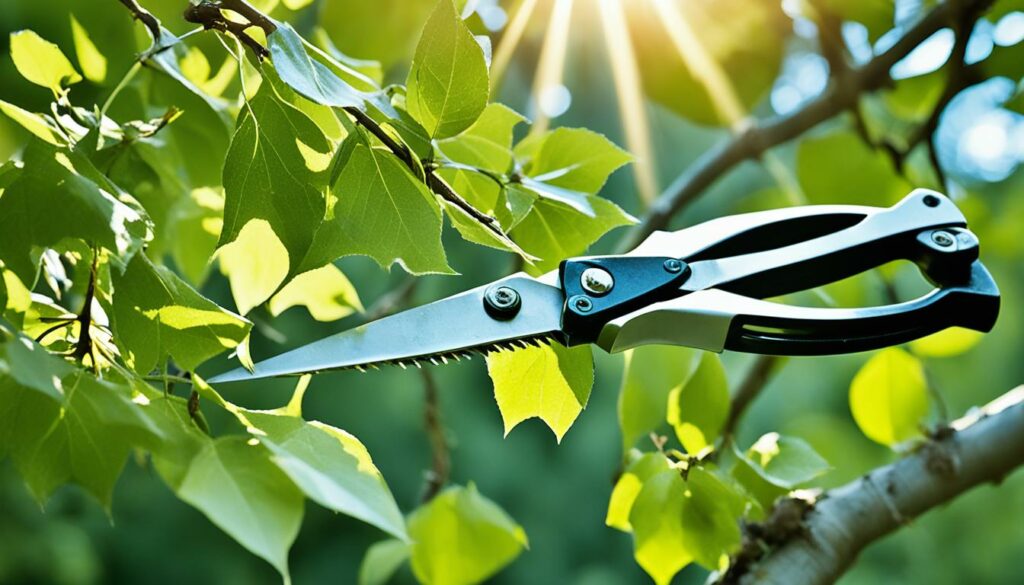
Late autumn to winter is the best time for most trees. It lets you see the tree’s structure well and avoids bugs and diseases. But if a tree gets hurt or vandalised, trim it right away to stop more harm. Make sure your tools are clean and sharp to protect the tree when cutting.
The Virginia Cooperative Extension gives useful guides for when to prune different trees. They suggest picking scaffold branches that are evenly spaced around the trunk. This keeps your tree strong and looks good. Regular careful trimming helps trees grow well and keeps your garden nice all year.
| Pruning Activities | Purpose |
|---|---|
| Removing Dead or Diseased Branches | To prevent the spread of disease and decay. |
| Pruning Water Sprouts and Suckers | To avoid interference with normal growth. |
| Selecting Scaffold Branches | To ensure a strong, attractive framework with proper angles of attachment. |
| Applying Heading and Thinning Cuts | To alter growth habits and improve light penetration and air circulation. |
| Using the Three-Cut Method | For safe removal of large limbs and to promote proper healing. |
Looking after diseased and damaged branches is key in garden care. Early spotting and safe removal of these branches make sure plants stay healthy. It also keeps the whole garden thriving. Cutting trees right in autumn helps the garden look beautiful and stay disease-free.
If you want to keep your garden healthy, you must find and remove diseased branches. Look for branches with odd colours, dieback, or fungi. These signs show the branch is sick and could make other parts of the plant sick too.
Cutting branches off right is crucial for the garden’s health. Make sure to cut near the branch collar for quick healing. Also, use clean tools like pruning shears for each cut. This stops sickness from spreading from one plant to another.
| Pruning Tool | Usage | Recommendation |
|---|---|---|
| Hand Pruning Shears | Cutting branches up to 1/2 inch in diameter | Well-suited for small twigs and precision cuts |
| Lopping Shears | Cutting branches up to 2 inches in diameter | Ideal for thicker branches; offers better leverage |
| Pole Pruners | Reaching and cutting higher branches | Ensures safety by allowing ground-level operation |
Good tree trimming and using the right tools are important for a healthy garden. Keep your tools clean and use them carefully. This helps keep diseases away and makes your plants grow strong and beautiful.
Swing into action this autumn and give your rose bushes a light prune. This will get them ready for winter. Take out the dead wood and any branches that look sick. Doing this will let more air and light in, and make your roses stronger for spring.
Water them well, making sure the water goes a foot deep into the soil. Drip irrigation works great to stop water running off. Adding a couple of inches of organic mulch not only keeps the soil moist, but it also stops weeds and keeps the roots cool.
| Rose Variety | Pruning Tips | Special Notes |
|---|---|---|
| ‘Knockout’ Rose | Remove old growth and shape lightly during autumn. | Renowned for its disease resistance and free-blooming nature. |
| Hybrid Teas | Prune to about half their previous growth, except if winter threat is high. | Higher phosphorus fertilisers recommended (e.g., 5-10-5). |
| Climbing Roses | Prune main canes horizontally after flowering for better blooms. | Minimal pruning needed in the first two to three years. |
| Oso Easy® Series | Minimal pruning and deadheading required. | Ideal for gardeners seeking vibrant blooms without extensive effort. |
When you prune, always cut just above a bud that’s pointing outwards. For types like hybrid teas, cut them down a lot if they’re not too hurt by winter. Save the big cuts for late winter or early spring, making the plants healthier. But in autumn, just focus on letting your rose bushes breathe better.
Spreading some lime, about 2 tablespoons per plant each year, keeps the soil friendly for roses. A mound of soft soil, about a foot high around the base, protects them from winter. And it’s better than using wet stuff like leaves or manure, which can spread disease.
If you live where winters are mild, leave the rose hips on for the season. This can help the roses rest better during the colder months. Good pruning is key for strong, flowery roses. So, snip away disease and make room for new growth.

Pruning is key for keeping fruit bushes healthy. It strengthens plant growth and boosts the fruit harvest. By pruning, we clear out extra branches. This opens up the plant, letting in more air and light. These are crucial for the plant’s health and fruit production.
Good pruning encourages the growth of new, fruitful wood. For example, cutting off branches that have already grown fruit gives space for new ones. This results in more fruit next season, and it’s better quality. It’s all about focusing the plant’s effort on top-quality fruit.
Pruning makes seasonal maintenance easier. It helps with things like organic spraying. How you prune can affect the amount and quality of the fruit. So, it’s important to know how to prune different fruit bushes.
When pruning, use the right tools for the job. Remember to keep these tools sharp and clean. This stops diseases from spreading. Plus, healthy tools help the bushes heal fast after pruning.
A well-pruned bush has space between branches. This allows light and air to reach all parts. This means strong, healthy branches that bear great fruit. Just be careful not to trim off more than a third of the branches in one year. This could stress the plant out.
Sepp Holzer in Austria has shown us that skipping pruning might mean less work. But, careful pruning is still needed for lots of good fruit and high quality.
Choosing the right pruning methods is essential for seasonal maintenance. It not only helps plants grow well but also leads to more and better fruit.
Pruning indoor plants is key for their health and looks. To keep them strong and avoid damage, careful cuts are necessary. Follow these tips for the best indoor plant care:
Keep your indoor plants in good shape by cutting off dead leaves. If a plant is too bushy, snip a bit. This not only makes your room look better but also keeps your plants healthy. Always use sharp tools to avoid hurting the plant. Clean cuts heal quicker.
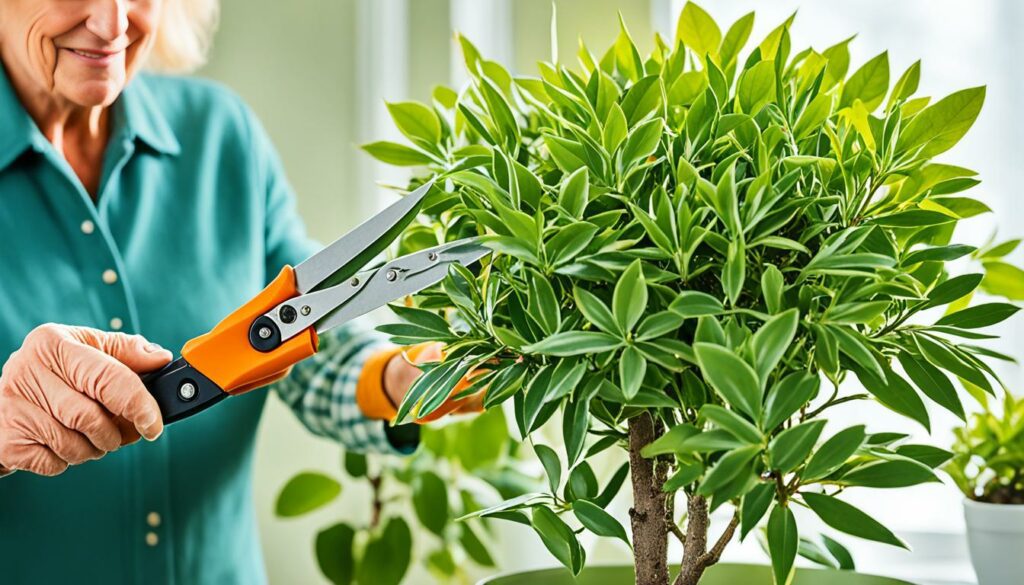
Only cut a quarter of the leaves at a time. This keeps the plant looking natural. When you prune, you can also grow new plants from the pieces you cut off. Less water after pruning is good to reduce stress. But still, watch for sickness or bugs because the plant’s defenses might be down.
Every plant needs a different trim. For plants that hang, like Pothos, cutting makes them thicker and not so spindly. But for indoor trees such as Ficus, it’s best to prune a bit at a time. This way, new growth comes from where you cut, shaping the plant better.
It’s better to do a small tidy-up in autumn, removing anything sick. Don’t cut too much then because plants struggle to grow back. Plants with soft stems should be nipped often to stay neat. Save the big cuts for late winter or spring when they grow most.
Caring for your indoor plants means they stay pretty and green all year. Use these pruning methods for a lively indoor garden. With the right cut, your plants will be both strong and beautiful.
Adding mulch after pruning does a lot for your garden. It helps keep the soil moist, stops weeds, and makes the soil richer as the mulch breaks down.
It’s best to have a 2- to 3-inch layer of mulch thick. But, you can use bigger materials like pine nuggets up to 4 inches deep. This is great for your garden. Spread mulch at least 8 feet around trees, up to the drip line or further.
Mulch keeps the soil warm in the winter and cool in the summer. It keeps moisture in and stops frost from harming plants.
Don’t put mulch in a mound near the trunk. This bad habit can hurt trees by making their roots rot or grow too close. Doing mulching right is key to keeping your garden healthy.
Properly pruned plants, along with mulch, make for strong growth. By cutting away the sick or dead parts and then mulching, you set your plants up for success. It’s a great way to care for them all year.
Consider getting advice from professional arborists from time to time. They know a lot about keeping trees healthy. Their help improves your garden care and maintenance.
Pruning is key for garden health. But, it’s vital to know the common mistakes. Over-pruning weakens plants. Taking off more than 20-30% of a plant at once is risky. It can invite pests and diseases. So, it’s crucial to prune wisely for a plant’s strength and health.
Heavy pruning in growth season can hurt plants. Too few leaves means less food for the tree. Cutting many branches might leave the bark unprotected from the sun, causing sunscald. Any time of year, over-pruning stresses a tree. This makes it easier for diseases to enter and harms the tree’s beauty. Topping trees to make them look bushier is very stressful for the tree.
Bad cutting techniques are a big mistake in trimming plants. Flush or stub cuts can stop trees from healing properly. Always make sure your cuts are clean and sharp. Dull tools can tear the bark. This lets in diseases. Use only sharp, clean tools for pruning.
Knowing these mistakes helps in successful pruning. Avoid over-pruning and bad cutting methods. This way, you’ll see better, healthier plants. Enjoy the benefits of a well-kept garden.
Fall pruning boosts plant growth and keeps your garden looking good. It helps plants put their energy in the right places. Always use sharp, clean tools to make the best cuts.
Fall trimming is key for the next season’s growth, disease prevention, and a nicer garden. By cutting off the dead bits, you stop bugs and make the plants stronger. It keeps everything in top shape.
Wait until plants lose their leaves and go dormant. This way, you can see clearly what needs cutting. For most plants, prune after the first frost to dodge winter pests.
You’ll need sharp shears for small twigs, loppers for thick bits, and a saw for big branches. Keep these tools clean and sharp to help your plants heal fast and stay healthy.
Get ready by cleaning your tools with rubbing alcohol. Wear gloves and eye protection too. Know your plant’s structure. This makes pruning safe and smart.
Trees need to lose their dead parts and make room for light and air. Shrubs get shaped by cutting back the overgrown bits. To help perennials fight off disease, cut them down after the first frost.
Deciduous trees need pruning when they’re dormant. With no leaves, you can see clearly and snip in the right spots. Focus on the sick bits and on shaping for future growth.
Look for warning signs like odd colours, dieback, or fungus. Cut cleanly at the branch’s base for quick healing. Each cut should be with a clean tool to avoid spreading sickness.
Roses like a light fall trim. Cut off dead and sick branches and thin them out. This helps them breathe and get more light, which makes them tougher for winter and ready for spring.
Trimming fruit bushes in autumn makes them healthier and more productive next year. By removing old fruit-bearing stems, you make space for new growth. This boosts the quality and quantity of your harvest.
Indoors, cut out dead or yellow leaves and balance the shape of the plant. Tidy up hanging plants for fuller growth. Carefully prune trees like ficus to avoid diseases. Remember to clean the leaves and cut down on water after pruning. Try planting the clippings to grow new plants.
Mulch after pruning to trap moisture, stop weeds, and give nutrients as it breaks down. It also protects roots from the cold and other winter harm.
Don’t take off too much or prune too often – it weakens plants. Stick to cutting only a quarter to a third at a time. Use the right snipping techniques to prevent disease. Correct methods keep your plants strong and beautiful.